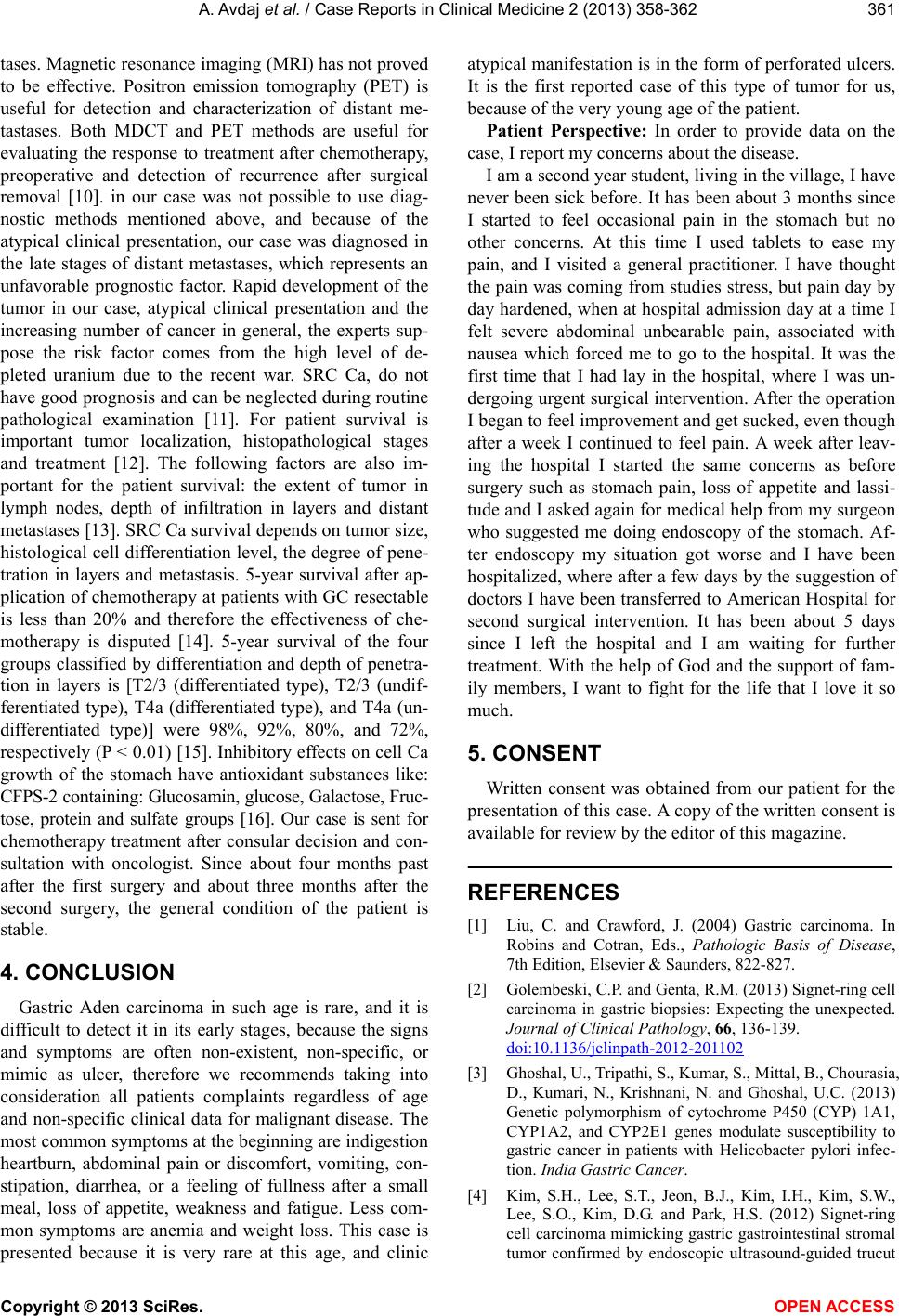
A. Avdaj et al. / Case Reports in Clinical Medicine 2 (2 013) 358-362 361
tases. Magnetic resonance imaging (MRI) has not proved
to be effective. Positron emission tomography (PET) is
useful for detection and characterization of distant me-
tastases. Both MDCT and PET methods are useful for
evaluating the response to treatment after chemotherapy,
preoperative and detection of recurrence after surgical
removal [10]. in our case was not possible to use diag-
nostic methods mentioned above, and because of the
atypical clinical presentation, our case was diagnosed in
the late stages of distant metastases, which represents an
unfavorable prognostic factor. Rapid development of the
tumor in our case, atypical clinical presentation and the
increasing number of cancer in general, the experts sup-
pose the risk factor comes from the high level of de-
pleted uranium due to the recent war. SRC Ca, do not
have good prognosis and can be neglected during routine
pathological examination [11]. For patient survival is
important tumor localization, histopathological stages
and treatment [12]. The following factors are also im-
portant for the patient survival: the extent of tumor in
lymph nodes, depth of infiltration in layers and distant
metastases [13]. SRC Ca survival depends on tumor size,
histological cell differentiation level, the degree of pene-
tration in layers and metastasis. 5-year survival after ap-
plication of chemotherapy at patients with GC resectable
is less than 20% and therefore the effectiveness of che-
motherapy is disputed [14]. 5-year survival of the four
groups classified by differentiation and depth of penetra-
tion in layers is [T2/3 (differentiated type), T2/3 (undif-
ferentiated type), T4a (differentiated type), and T4a (un-
differentiated type)] were 98%, 92%, 80%, and 72%,
respectively (P < 0.01) [15]. Inhibitory effects on cell Ca
growth of the stomach have antioxidant substances like:
CFPS-2 containing: Glucosamin, glucose, Galactose, Fruc-
tose, protein and sulfate groups [16]. Our case is sent for
chemotherapy treatment after consular decision and con-
sultation with oncologist. Since about four months past
after the first surgery and about three months after the
second surgery, the general condition of the patient is
stable.
4. CONCLUSION
Gastric Aden carcinoma in such age is rare, and it is
difficult to detect it in its early stages, because the signs
and symptoms are often non-existent, non-specific, or
mimic as ulcer, therefore we recommends taking into
consideration all patients complaints regardless of age
and non-specific clinical data for malignant disease. The
most common symptoms at the beginning are indigestion
heartburn, abdominal pain or discomfort, vomiting, con-
stipation, diarrhea, or a feeling of fullness after a small
meal, loss of appetite, weakness and fatigue. Less com-
mon symptoms are anemia and weight loss. This case is
presented because it is very rare at this age, and clinic
atypical manifestation is in the form of perforated ulcers.
It is the first reported case of this type of tumor for us,
because of the very young age of the patient.
Patient Perspective: In order to provide data on the
case, I report my concerns about the disease.
I am a second year student, living in the village, I have
never been sick before. It has been about 3 months since
I started to feel occasional pain in the stomach but no
other concerns. At this time I used tablets to ease my
pain, and I visited a general practitioner. I have thought
the pain was coming from studies stress, but pain day by
day hardened, when at hospital admission day at a time I
felt severe abdominal unbearable pain, associated with
nausea which forced me to go to the hospital. It was the
first time that I had lay in the hospital, where I was un-
dergoing urgent surgical intervention. After the operation
I began to feel improvement and get sucked, even though
after a week I continued to feel pain. A week after leav-
ing the hospital I started the same concerns as before
surgery such as stomach pain, loss of appetite and lassi-
tude and I asked again for medical help from my surgeon
who suggested me doing endoscopy of the stomach. Af-
ter endoscopy my situation got worse and I have been
hospitalized, where after a few days by the suggestion of
doctors I have been transferred to American Hospital for
second surgical intervention. It has been about 5 days
since I left the hospital and I am waiting for further
treatment. With the help of God and the support of fam-
ily members, I want to fight for the life that I love it so
much.
5. CONSENT
Written consent was obtained from our patient for the
presentation of this case. A copy of the written consent is
available for review by the editor of this magazine.
REFERENCES
[1] Liu, C. and Crawford, J. (2004) Gastric carcinoma. In
Robins and Cotran, Eds., Pathologic Basis of Disease,
7th Edition, Elsevier & Saunders, 822-827.
[2] Golembeski, C.P. and Genta, R.M. (2013) Signet-ring cell
carcinoma in gastric biopsies: Expecting the unexpected.
Journal of Clinical Pathology, 66, 136-139.
doi:10.1136/jclinpath-2012-201102
[3] Ghoshal, U., Tripathi, S., Kumar, S., Mittal, B., Chourasia,
D., Kumari, N., Krishnani, N. and Ghoshal, U.C. (2013)
Genetic polymorphism of cytochrome P450 (CYP) 1A1,
CYP1A2, and CYP2E1 genes modulate susceptibility to
gastric cancer in patients with Helicobacter pylori infec-
tion. India Gastric Cancer.
[4] Kim, S.H., Lee, S.T., Jeon, B.J., Kim, I.H., Kim, S.W.,
Lee, S.O., Kim, D.G. and Park, H.S. (2012) Signet-ring
cell carcinoma mimicking gastric gastrointestinal stromal
tumor confirmed by endoscopic ultrasound-guided trucut
Copyright © 2013 SciRes. OPEN ACCESS